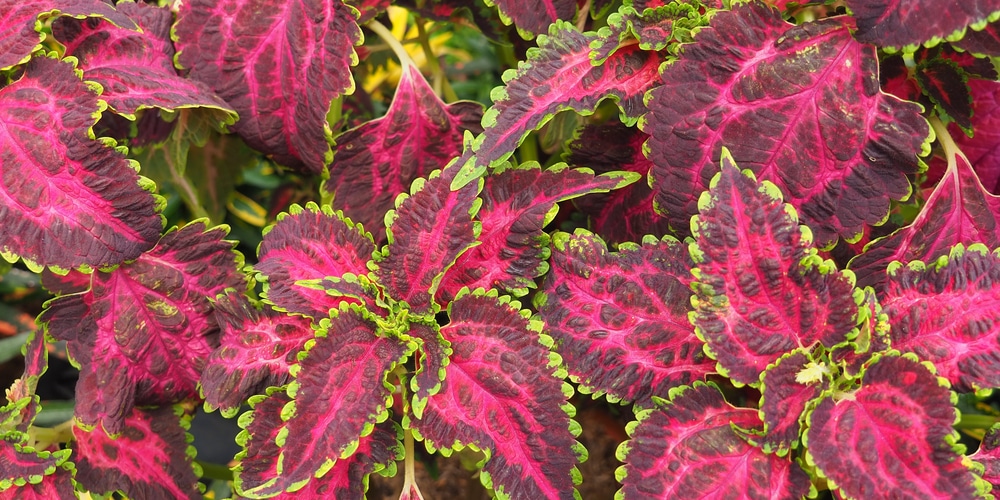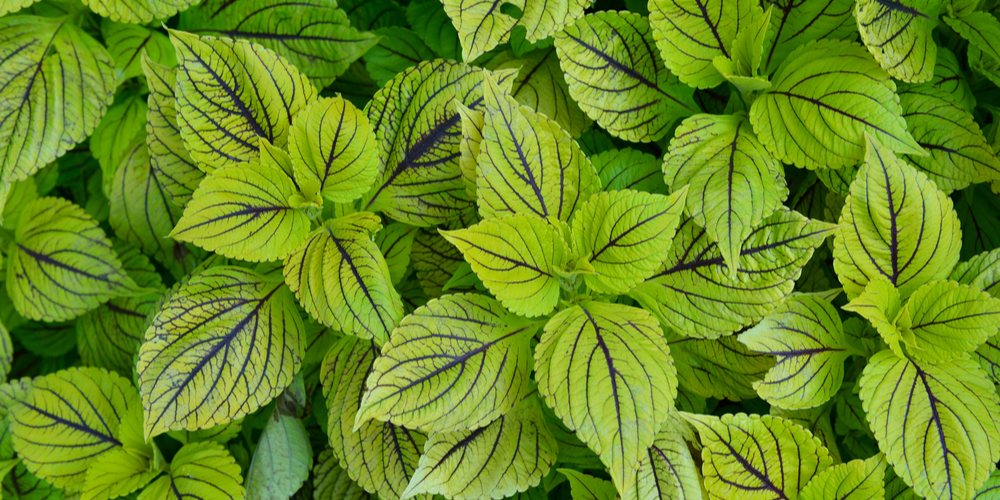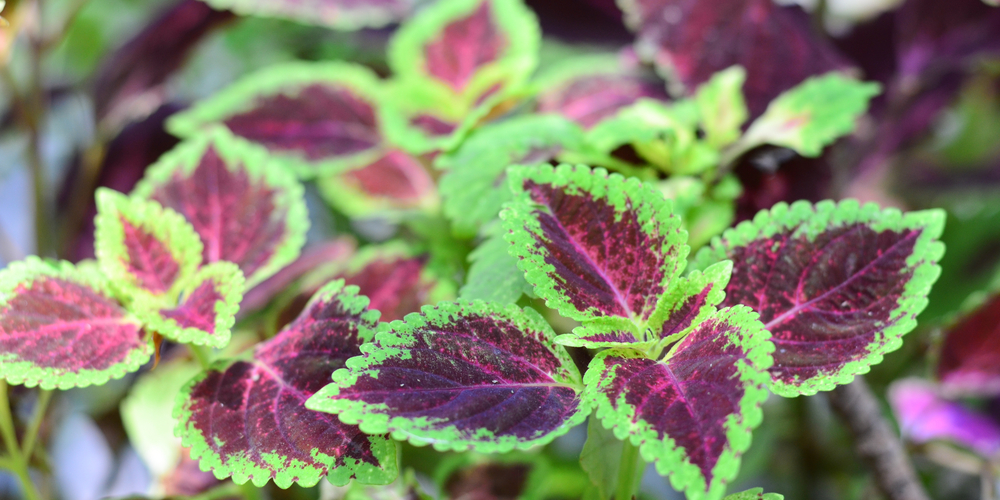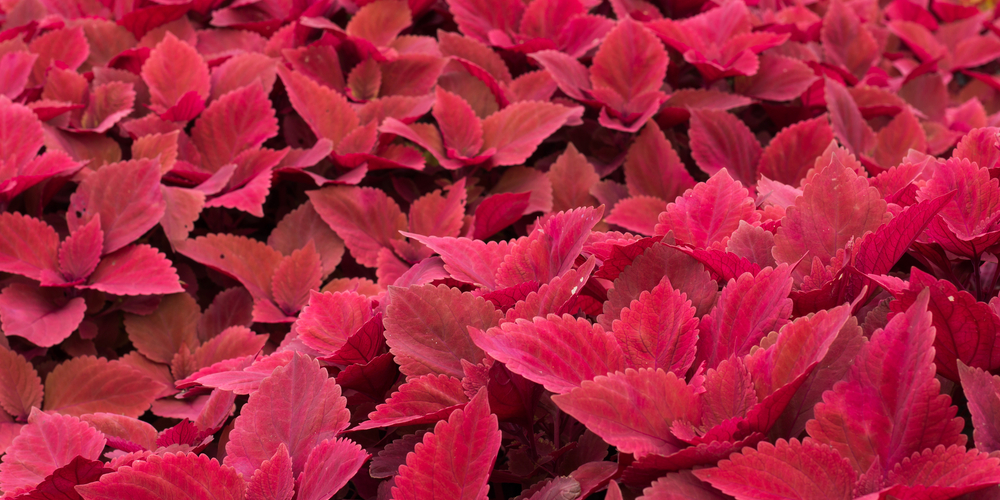Coleus varieties add many bright colors to your backyard or garden. For clarity, the genus Coleus includes more than 290 species. So, you have many types and shapes you can choose from when picking this outdoor tropical herb.
What is the best coleus variety for shade? Most people choose a coleus plant by judging its hues. Its colors range between dark purple, rosy red, bright green, soft yellow, and vivid pink. Sometimes, they have white leaf tips or borders as well. You can also start a coleus collection and employ a process of elimination.
Creating A Shade Garden With Coleus Plants: The Basics
Most coleus varieties are by far some of the best foliage-type perennials you can get for your garden. In fact, some sellers call them “landscape coleus” and give them self-explanatory names like Rustic Orange, Electric Coral, or Kingswood Torch.
These bedding plants start from seed and get quickly larger and taller. In a humid climate, they can even withstand direct sunlight. But they thrive the more you treat them as shade plants. As long as the temperature is above 50F (10C), that is.
All coleus plants need plenty of organic compost and indirect sunlight. But you also need to make sure the soil drains well if you want to make the perfect shade garden.
8 Best Coleus Varieties For Your Shade Garden
1. Dipt In Wine Hybrids
The hybrid coleus varieties known as “dipt in wine” have one thing in common. That is, a magnificent ruby-red coloration. They are the ideal choice for shade gardens and planting under trees. The contrast against the bare brown soil is perfect. But they have many landscape applications as well.
Their deep burgundy or wine color is its most striking feature. Then again, the margin is bright green or yellow. So, you can use together with other coleus plants to make hundreds of eye-catching pairs.
The best thing about Dipt in Wine varieties is that you do not need to plant an enormous number of them to make a statement.
2. Gays Delight
Gays Delight coleus plants develop dark veins. Sometimes, they become red. But other times, they remain lime green with dark purple veins, which look amazing.
You can use them at the edges of your shade garden because they can also withstand full sun. Or put them in hanging baskets. But they will turn red the more light they receive.
Unlike weaker coleus varieties, they are heat tolerant and ward off many pests without your help. But they like periodic watering and consistency above anything else. So, keep its soil moist to protect its attractive features.
3. Henna Lace
Among the shade-loving coleus varieties, the Henna Lace coleus (sometimes referred to as Henna Lace mayana) is the most prolific. You have to keep nipping its sprouts to keep it bushy and compact.
Every spring, pinch and remove all the shoots you see to keep its foliage full and luxurious. Otherwise, the plant will keep growing straight up without any lateral branching. You do not need a pruner and can use your fingers because this variety is resilient.
Its pink leaf veins make the Henna Lace the ideal plant to visually separate darker plants in your shade garden.
4. Kong Rose
Kong Rose coleus plants get dried out in the sun. So, they are they deserve a place among the ideal coleus varieties for shade gardens.
This velvety-looking plant would catch anyone’s eye from several yards away. On average, 7 out of 10 growers fall in love with its vibrant black cherry hue and bright green leaf edges.
A healthy Kong Rose looks pretty symmetrical and develops big leaves. But if you want a larger coleus plant, get the Kong Scarlet. In any case, make sure to give it plenty of fertilizer during the warm season and to keep the soil moist.
5. Red Head
Here is one of the most known coleus varieties. In brief, the Coleus Scutellarioides Red Head gets all red from stem to leaves. And like its sibling Othello, it is drop-dead gorgeous.
When winter rolls around, a Red Head coleus is the perfect addition to your indoor garden. But it has tender roots, so they can dry out fast if you keep the plant near a heat source. Cut the plant back to help it deal with the lack of sunlight. You can also propagate the cuttings in new pots. In this way, they will be ready for your shade garden next spring.
6. Royal Glissade
The Royal Glissade’s leaves resemble fall foliage. If you grow it indoors, the plant retains an elegant dark-green color. It also gets even darker leaf borders. But when exposed to sunlight or many hours of indirect sunlight, it colors itself reddish-yellow.
The award-winning Colorblaze Royal Glissade has been on the market for more than a decade. Above all, most enthusiasts love it because it brings beautiful texture to the shade garden. Plus, it does not flower, and you can move it in the sun whenever you want.
This variety gets a 2 out of 10 on the difficulty scale. So, it is a great first choice for beginners.
7. Tilt A Whirl
The Tilt a Whirl coleus plant grows a rich ruby canopy. But it will grow wild if you ignore it for a while. On the other hand, it will look wilted and slump over when you transplant it. Fret not, because this plant love to act weak, but it is tough and resilient.
Do not overwater this plant after transplanting it. In a few days, the plant will bounce right back. Just like nothing ever happened. But if you give it too much water, it will perish.
8. Wasabi
Most likely, the Wasabi is the greenest variegation of all coleus varieties. They only remain green if they get indirect light at all times. But if you care for them properly, they can get morning sun (from 7:00 a.m. to 10:00 a.m. tops) and benefit from it.
If you want them to speed up their growth rate, consider putting them under bright artificial light instead.
Related articles: Window Well Plant Ideas




